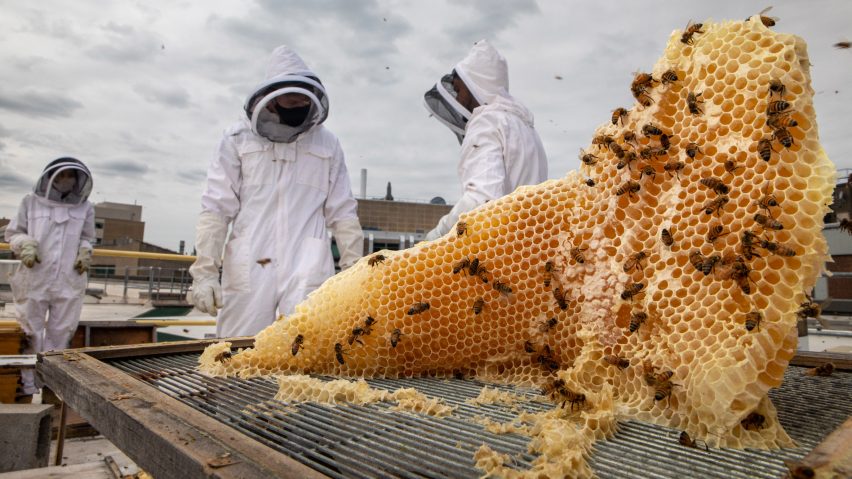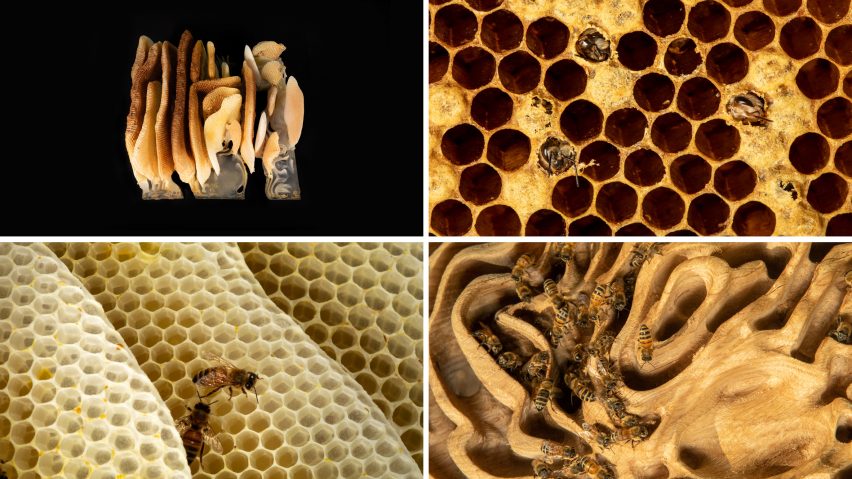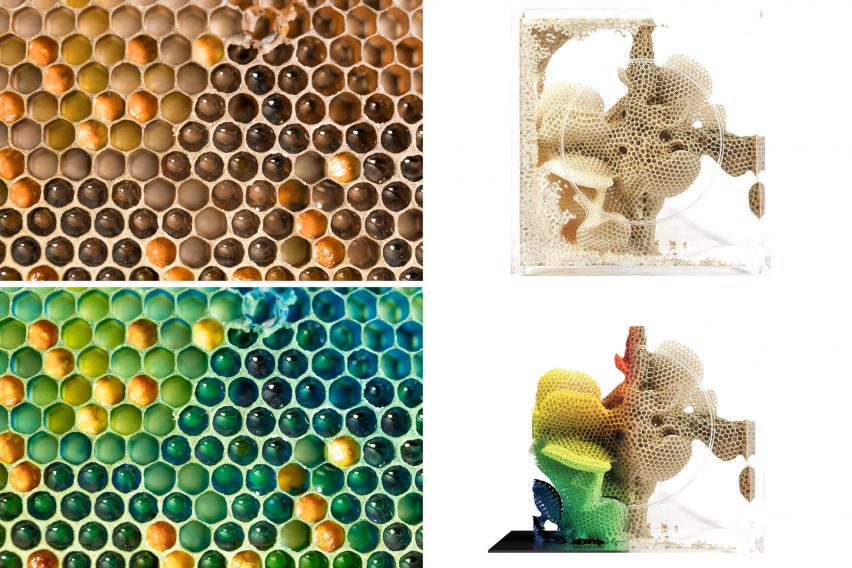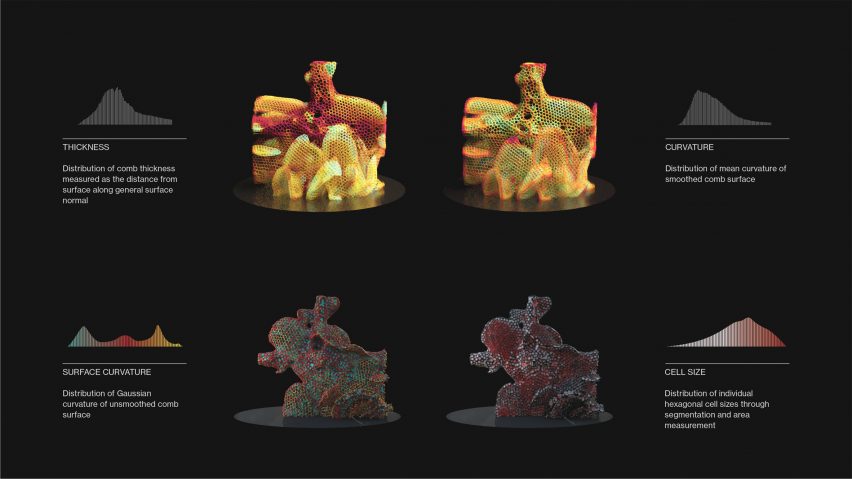
Neri Oxman's Synthetic Apiary II shows how beehive construction "is a responsive and dynamic process"
In this article prepared as part of Neri Oxman's contribution to the Dezeen 15 festival, the architect and designer describes a synthetic apiary designed to study how honey bees collaborate to build comb structures.
As part of the festival, Oxman also contributed a manifesto and movie and took part in a live video interview with Dezeen founder and editor-in-chief Marcus Fairs.
Designed in collaboration with The Mediated Matter Group at MIT, Synthetic Apiary II allows researchers to track and monitor the behaviour of bees using computational tools. It builds on the work of Synthetic Apiary I, which Oxman and The Mediated Matter Group created in 2016.
Through studying the bees and their honeycomb structure creations, researchers are able to gather insights into how designed environments might be used in human architecture and design.
To Bee or Not to Bee
Synthetic Apiary II by Neri Oxman and The Mediated Matter Group
Global biodiversity is declining faster than ever before, with an unprecedented one million species on our planet currently at risk of extinction. Perhaps most alarming is the massive decline in bees worldwide, due to various factors affecting their health such as agricultural chemicals, disease, and habitat loss.
Like silkworms, honey bees, including Apis mellifera, are incredibly interesting model organisms because of the historical interplay between their communities and their role in human culture. As agents of pollination, bees are integral to roughly 70 per cent of our edible flowering crops; without them, we would not have the fruits and the vegetables that nourish our lives on Earth.
They may even be key to supporting the regenerative food systems necessary for long-term space missions (for related work, see Smith et al. 2021). The cultivation of bees, education about their health, and advancement of non-standard bee environments has become increasingly important for their survival, and for ours.
Towards that end, Synthetic Apiary I demonstrates a controlled space in which seasonal honey bees can thrive year-round. Light, humidity, and temperature were engineered to simulate a perpetual spring environment where honey bees were provided with synthetic pollen and sugared water and evaluated regularly for health and wellbeing.
As a platform for biological research, this enables longitudinal studies of behavioral dynamics across scales, from the organism scale to the building scale – including bee health, comb-construction behaviors and bee-human interactions.

A marker of successfully engineered environmental and nutritional conditions for honey bees is the ability of the queen to adapt her biological cycle to the new environment, inducing egg laying; we were thrilled to document on video the first birth of a bee in the Synthetic Apiary.
This proved the ability to shift the entire cycle of bee behavior, out of winter mode and into spring mode, and is a first demonstration of sustainable life in a completely synthetic apiary. Taking the long view, we envision the integration of biology into a new kind of architectural environment, itself integrated into a city, for the benefit of humans and non-human organisms alike.
Looking back over hundreds of years, humans have observed natural living systems, fascinated by and constantly learning from their sociobiological dynamics. Many insect communities present collective behavior known as swarming, prioritizing group over individual survival, while constantly working to achieve common goals.
Often, groups of these eusocial organisms leverage collaborative behavior for relatively large-scale construction. For example, ants create extremely complex networks by tunneling, wasps generate intricate paper nests with materials sourced from local areas, and bees deposit wax to build intricate hive structures.
Among these tiny architects, bees are known for creating beautiful and complex wax hives that can house tens of thousands of individuals, all working together in an exquisite demonstration of eusocial behavior. The architecture of honey bee combs embodies a range of expressions associated with swarm intelligence, emergent behaviors and social organization.
Using only abundant, organic resources, honey bees collaborate to create functional structures from comb without the use of any top-down blueprints. Rather, their collective actions give rise to a structure that suits the colony’s needs. The specific behaviors, actions, and design decisions that drive this emergent design process, however, remain relatively unknown. If we could better understand these factors, we might learn how to incorporate them into our own construction practices – not only to cohabitate but also to co-fabricate with bees.
Synthetic Apiary II investigates co-fabrication between humans and honey bees through the use of designed environments in which Apis mellifera colonies construct comb. These designed environments serve as a means by which to convey information to the colony. The comb that the bees construct within these environments comprises their response to the input information, enabling a form of communication through which we can begin to understand the hive’s collective actions from their perspective.

Some environments are embedded with chemical cues created through a novel pheromone 3D-printing process, while others generate magnetic fields of varying strength and direction. Others still contain geometries of varying complexity or designs that alter their form over time.
When offered wax augmented with synthetic biomarkers, bees appear to readily incorporate it into their construction process, likely due to the high energy cost of producing fresh wax. This suggests that comb construction is a responsive and dynamic process involving complex adaptations to perturbations from environmental stimuli, not merely a set of predefined behaviors building toward specific constructed forms. Each environment therefore acts as a signal that can be sent to the colony to initiate a process of co-fabrication.
Characterization of constructed comb morphology generally involves visual observation and physical measurements of structural features—methods which are limited in scale of analysis and blind to internal architecture. In contrast, the wax structures built by the colonies in Synthetic Apiary II are analyzed through high-throughput X-ray computed tomography (CT) scans that enable a more holistic digital reconstruction of the hive’s structure.
Geometric analysis of these forms provides information about the hive’s design process, preferences, and limitations when tied to the inputs, and thereby yields insights into the invisible mediations between bees and their environment.
Developing computational tools to learn from bees can facilitate the very beginnings of a dialogue with them. Refined by evolution over hundreds of thousands of years, their comb-building behaviors and social organizations may reveal new forms and methods of formation that can be applied across our human endeavors in architecture, design, engineering, and culture.
Further, with a basic understanding and language established, methods of co-fabrication together with bees may be developed, enabling the use of new biocompatible materials and the creation of more efficient structural geometries that modern technology alone cannot achieve.

In this way, we also move our built environment toward a more synergistic embodiment, able to be more seamlessly integrated into natural environments through material and form, even providing habitats of benefit to both humans and nonhumans. It is essential to our mutual survival for us to not only protect but moreover to empower these critical pollinators – whose intrinsic behaviors and ecosystems we have altered through our industrial processes and practices of human-centric design – to thrive without human intervention once again.
In order to design our way out of the environmental crisis that we ourselves created, we must first learn to speak nature’s language. While most architecture and design concerns itself with the needs of humans alone, we urge designers to embrace nature-centric design, taking responsibility for the impact that structures have on other living systems.
Entering into cross-kingdom relationships deliberately stands in contrast to the typical anthropocentric view and acknowledges that we cannot operate in isolation as we build and create. Instead, we must seek to harness synergistic interactions towards the empowerment of all life, in our biosphere and beyond.
Project credits:
Synthetic Apiary I: Markus Kayser, Sunanda Sharma, Jorge Duro-Royo, Christoph Bader, Dominik Kolb, and Prof. Neri Oxman.
Synthetic Apiary II: Christoph Bader, Nic Lee, Rachel Smith, Ren Ri, Felix Kraemer, João Costa, Sunanda Sharma, James Weaver, and Prof. Neri Oxman.
Collaborators: The Best Bees Company: Dr. Noah Wilson-Rich, Philip Norwood, Jessica O’Keefe, Rachel Diaz-Granados; Super Bee Rescue, Nick Wigle; Julia Freitag; Dr. James Weaver (Wyss Institute); Dr. Anne Madden (North Carolina State University); Space Managers: Andy and Susan Magdanz, and Daniel Maher. Photography and Videography: Lauren Owens Lambert, James Day, The Mediated Matter Group. Media Lab Facilities: Jessica Tsymbal and Kevin Davis. MIT EHS: Lorena Altamirano. Generously sponsored by the Mori Building Company and supported by the Mori Art Museum and Loftworks.
Technical publications:
Smith, R. S. H., Kraemer, F., Bader, C., Smith, M., Weber, A., Simone-Finstrom, M., Wilson-Rich, N., & Oxman, N. (2021). A rapid fabrication methodology for payload modules, piloted for the observation of queen honey bees (Apis mellifera) in microgravity. Gravitational and Space Research, 9(1), 104–114. https://doi.org/10.2478/gsr-2021-0008
The imagery is courtesy of Neri Oxman and The Mediated Matter Group.